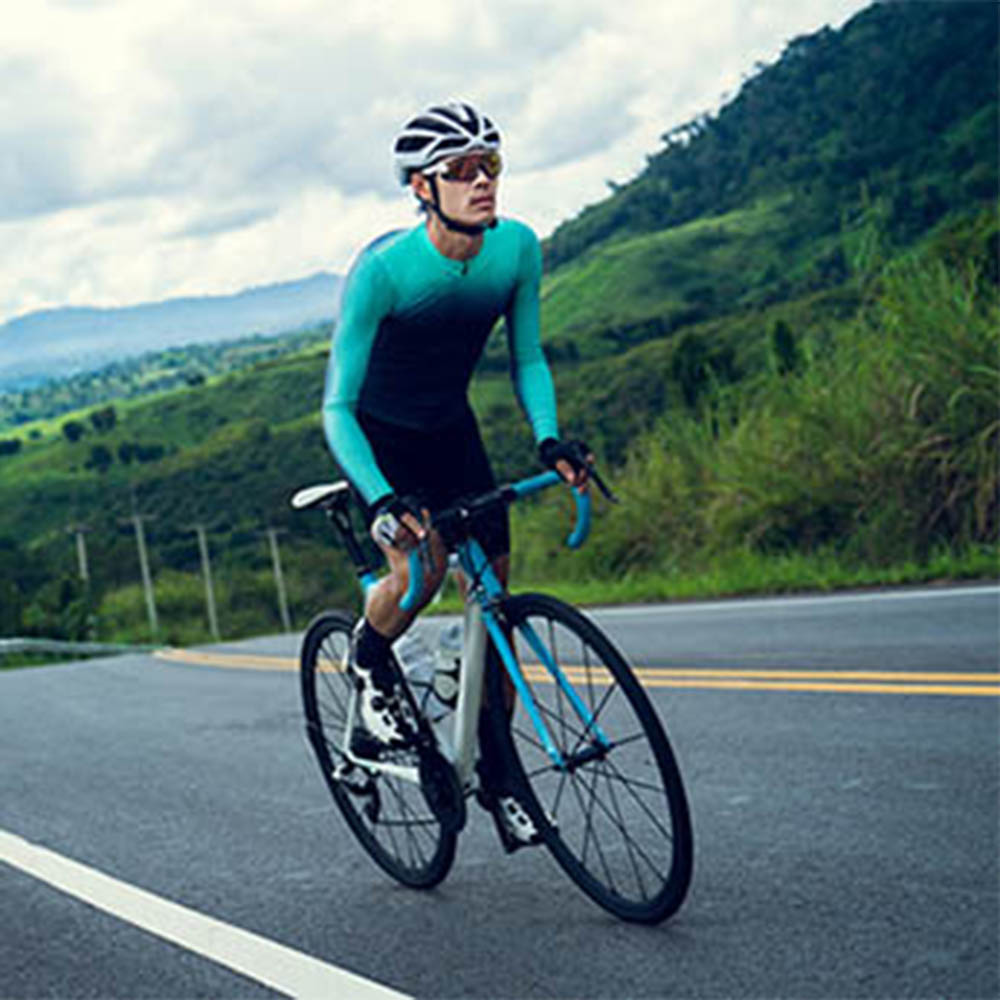How to Prevent the Most Common Bicycle Injuries
Individual sports have their own unique problems. Runners often have problems with their knees and hips. Baseball players frequently injure their hands, elbows, and shoulders. Football players are prone to head injuries. There are many activities and sports for mountaintop adventures in the French Alps, but cycling is the most popular. Cycling also has unique injuries, and being aware of them is a step in prevention.
wear a helmet
Cycling injuries can involve different parts of the entire body. Head injuries are one of the most common injuries and the easiest way to prevent it is to wear a helmet. While helmets may not guarantee that a fall won’t result in a head injury, they have been shown to reduce severity. In a study published in the journal Accident; Analysis and Prevention, it was found that wearing a bicycle helmet “reduced a 48% reduction in head injuries, a 60% reduction in serious head injuries, a 53% reduction in traumatic brain injuries, a 23% reduction in facial injuries, and a 23% reduction in There was a 34% reduction in the total number of fatalities or serious injuries among car occupants.” The results of this study have been confirmed in repeated studies.
Photography: rawpixel.com
Unfortunately, the community does not require cyclists to wear helmets. The usual task of a chiropractor is to help people injured in bicycle accidents. A study published in Chiropractic & Manual Therapies reports that people who have had a bicycle accident seek care from a chiropractor first, with or without an emergency room evaluation. Chiropractors always recommend that cyclists wear helmets, even if they are not required by law.
Photo by Pixabay
Prevent low back pain
When riding a bicycle, it is common to experience pain in the lower back. Researchers repeatedly looked at the optimal form of sitting on a bike seat, and they also looked at gear, terrain and other causes of lower back pain in recreational cyclists. In a study published in the International Journal of Exercise Science, recreational cyclists complained of low back pain if they cycled more than 37 miles per week. Cyclists who cycled less than this were nearly four times less likely to report any low back pain.
Until research finds other causes of low back pain in recreational cyclists, the best way to prevent it is to ride less than 37 miles per week. As reported in the Journal of Graduate Medicine, low back pain often comes from repeated use. So for cyclists who haven’t been trained to ride for long periods of time (like competitive cyclists), cycling too many miles may just be too much repetitive stress.
Photography: rawpixel.com
To prevent repetitive overuse of the back muscles and joints – even the cervical spine. Cyclists should adjust their position throughout the ride. Cyclists often stretch their necks and shoulders while riding, but they only do so in a safe place. Another way to prevent this problem is to set up the bike for your body. Your handlebars shouldn’t be set too low or your back and neck will become too rounded and uncomfortable.
Stretching the hamstrings can also help prevent low back pain. Cyclists don’t seem to benefit from flexible hamstrings, but they do. According to the Asian Spine Journal, when patients experience low back pain, their range of motion in the pelvis and trunk is limited. While researchers found that the hamstring doesn’t directly affect the lower back, it does affect pelvic tilt. Also, pelvic tilt affects the way a cyclist sits on the seat, which in turn affects the lower back. The indirect link between the hamstrings, pelvic position, and lower back does make a difference for cyclists. Therefore, to prevent low back pain, cyclists should stretch their hamstrings before riding.
Photography: rawpixel.com
It also helps to have the seat set in a comfortable position so the back stays straight during the ride. When you’re on a long ride with an unnatural back bend, your back muscles work hard and get tired. Since the back cannot be seen when riding, it is recommended to go to a bike shop to adjust the seat and handlebars.
Prevent hand, wrist and arm pain
Cyclists, especially those who enjoy mountain biking, often suffer from arm, wrist, and/or hand injuries. The researchers published a report in the journal Hand on the best ways to prevent upper extremity injuries. After studying how mountain bikers fall, they recommend that cyclists wear protective gear to prevent common radius (forearm bones), navicular (small bones in the wrist), and metacarpals (long bones in the hands) injuries .
Photography: rawpixel.com
Many hand, wrist and arm injuries are caused by speeding or car crashes. If your upper body still hurts, then there are a few things you should look at: your bike and your work environment. If you use a keyboard and work environment
ironment is not designed ergonomically, wrist and hand pain while cycling could actually be caused by your workplace. Hand and wrist pain could also be caused by a bike that is not set up properly. Your handlebars could be too low or too high. Or your handlebars could vibrate too much. Even the grips could be wrong for your body and the terrain you choose.
Fortunately, there are a few other things you can do besides readjusting your cycle or buying different grips. Some people find that moving their hands around while cycling prevents pain. You can put your hands on your grips or the hoods, open and close your fists occasionally, and wiggle your fingers when you can. Moving the hands activates the muscles and tendons. It gets blood and oxygen flowing. It also prevents numbness from sneaking in and wreaking havoc on an otherwise good ride. You can also prevent numbness and pain by using a relaxed grip when appropriate.
Of course, if any of these problems or others become persistent, it is wise to seek help from your health care provider who will be able to give you even more advice.
Feeling more prepared and inspired?
Hopefully this article has left you feeling inspired to jump on the the road in the alps with all your protective gear, knowledge of prevention and perfectly adjusted bike! If you feel like testing your metal on an Alpine holiday, just complete our enquiry form and we ‘ll get back to you today with some accommodation options to consider. It’s more than just a cycling holiday with Peak Adventures… MUCH MORE!

Professional training tips for any cyclist
You may find that not all of these tools are right for your needs, but you can often mix and match to find the perfect balance of skills and tools, and your riding skills will improve greatly over time. Be willing to try all of these techniques, but don’t be afraid to pass on those that don’t fit your unique training style.
1. Cross-training and different sports
While you want to spend all your time on the bike every time you work out, there are great benefits to cross-training. Take a yoga class, run or hike at least one or two days a week. As an athlete, being able to diversify your skill set can create huge results for your health and make you a more capable athlete.
Cross-training can improve cardiovascular fitness, and training your core muscles through Pilates, swimming, or even hiking can improve balance and efficiency on the bike. Most importantly, these small changes in your routine can help you break free from your routine every now and then.
2. Push hard when you are tired
If you’ve been working out hard when you’re fresh, you may be missing out on the cardio and fitness potential you can only train when you’re tired. Your body will need to learn to operate under new levels of fatigue and stress to build strength and fitness. You should spend at least a few days a week cycling until you feel fatigued, then add strength or sprints for short periods of time.
These stressful training moments can greatly improve your overall fitness, and you’ll find that when you’re tired and push hard, your strength and stamina increase a lot. You don’t have to do this part of the workout every day, you can even keep these short bursts of stress to about 5 to 10 minutes or less.
3. Ride at a steady pace
A stable pace setting really helps improve your overall ability to ride long distances effectively. For those planning on long rides or races, you need to be able to ride at slightly uncomfortable challenging speeds for extended periods of time to stay competitive or to improve your overall long rides ability.
To train with this method, set your pace slightly faster to ensure comfort and ride for as long as possible. Every day you should try to go a little further. This will increase over time and you will find that you will be able to ride long distances with ease.
If you are looking for a new way of commuting or want a healthier lifestyle, we are here to help you. Visit our website to learn more about electric bikes and electric scooter or please leave information to us.


 Shuangye ebike
Shuangye ebike
